
Press Release
Mayors from around the world sign Paris Declaration to end the AIDS epidemic
01 December 2014 01 December 2014On World AIDS Day, mayors meet in Paris as UNAIDS releases a new report on the huge potential of fast-tracking the AIDS response in cities
PARIS/GENEVA, 1 December 2014—On World AIDS Day 2014, mayors from around the world came together in Paris, France, to sign a declaration to end the AIDS epidemic in their cities. In signing the 2014 Paris Declaration, the mayors commit to putting cities on the Fast-Track to ending the AIDS epidemic through a set of commitments. Those commitments include achieving the UNAIDS 90–90–90 targets, which will result in 90% of people living with HIV knowing their HIV status, 90% of people who know their HIV-positive status on antiretroviral treatment and 90% of people on treatment with suppressed viral loads, keeping them healthy and reducing the risk of HIV transmission.
“Ending the AIDS epidemic is achievable if the world’s major cities act immediately and decisively to fast-track their AIDS responses by 2020,” said Michel Sidibé, Executive Director of UNAIDS. “A Fast-Track AIDS response in cities will also encourage new, cutting-edge service delivery programmes that can pave the way for cities to address other public health challenges, including tuberculosis, sexual and reproductive health, maternal and child health, gender-based violence and noncommunicable diseases.”
At the World AIDS Day event in Paris, hosted by the Mayor of Paris, Anne Hidalgo, the mayors joined the Joint United Nations Programme on HIV/AIDS (UNAIDS), the United Nations Human Settlements Programme (UN-Habitat) and the International Association of Providers of AIDS Care (IAPAC) in signing the Paris Declaration. “Cities all over the world are key players that can fast-track the response in order to ultimately end the AIDS epidemic,” said Anne Hidalgo, Mayor of Paris. “Our duty is above all a human one. As elected representatives, our choice is to demonstrate solidarity. In Paris, we are determined to take our responsibilities and to live up to our commitments.”
The meeting is taking place 20 years after the Paris AIDS Summit, at which world leaders and communities agreed to a set of principles for the greater involvement of people living with HIV. Known as the GIPA principles, the historic commitment continues to guide the global AIDS response today.
During the event, UNAIDS released a report on HIV in cities, which outlines the important role that urban areas will play in ending the AIDS epidemic by 2030. The OUTLOOK: cities report shows how cities and urban areas are particularly affected by HIV, with the 200 cities most affected by the epidemic estimated to account for more than a quarter of the 35 million people living with HIV around the world. In many countries, cities are home to more than half of all people living with HIV across the country. In sub-Saharan Africa, 45% of people living with HIV reside in cities.
According to the report, more than half the world’s population lives in cities, with the proportion set to expand to 60% by 2050. The vast majority of megacities, defined as having populations of more than 10 million people, will be in low- and middle-income countries. Fast-tracking HIV responses in cities—without neglecting efforts in rural and other areas—will therefore be crucial to ending the AIDS epidemic.
The 2014 Paris Declaration includes commitments to focus on the communities most affected by HIV, to mobilize resources for the better integration of public health and development, to build and accelerate urban HIV strategies and to use the AIDS response as a catalyst for positive social transformation.
“Cities provide ready, flexible and creative platforms that can contribute to ending the AIDS epidemic in a pragmatic, balanced and efficient way,” said Joan Clos, Executive Director of UN-Habitat. “Cities can act as the fora where the linkages, trust, respect and inclusiveness that are part of any sustainable solution can be built.”
The Cities report shares the city photography of renowned photographer Richard Silver. It also features testimonies from community activists, health workers and public officials who have been at the forefront of the AIDS response in the world’s cities. Their stories show how the same urban centres that have been most affected by HIV from the beginning of the epidemic are now uniquely positioned to end the AIDS epidemic. It also highlights the importance of ensuring that people who are marginalized and often stigmatized—including sex workers, people who inject drugs and men who have sex with men—have access to HIV prevention and treatment services.
Tackling poverty and inequality will also be essential. Globally, an estimated 1 billion people live in poverty, with access to only a few services. Poverty and inequality are further tested by multiple health challenges, including HIV and related diseases, such as tuberculosis, the leading cause of death among people living with HIV.
“We must seize this moment of unprecedented scientific opportunity to rapidly reduce the number of new HIV infections and end AIDS-related deaths, without ignoring significant barriers to achieving the 90–90–90 targets in cities, including stigma and discrimination,” said José M. Zuniga, President/CEO of IAPAC. “Achieving these targets requires thinking globally and acting locally, leveraging existing city programmes and resources and implementing locally relevant, locally tailored and locally led interventions to address HIV prevention, testing and treatment gaps.”
Ending the AIDS epidemic in the world’s cities will require leaders who can inspire and harness the compassion and generosity of ordinary urban citizens in order to bring about lasting change. It will depend upon energized communities accelerating and sharpening the focus of local AIDS responses and sharing best practices across urban centres.
In addition to the 90–90–90 targets, UNAIDS also calls for reducing the annual number of new adult HIV infections by more than 75%, to 500 000 in 2020, and achieving zero discrimination. UNAIDS estimates that reaching the 90–90–90 Fast-Track Targets will prevent almost 28 million new HIV infections and 21 million deaths by 2030.
Mairie de Paris
Paris, the capital of the French Republic, has been committed to the AIDS response for more than 30 years through its associations, doctors, hospitals and political leaders. Paris also provides € 2 million each year in funding for international assistance for HIV, particularly in sub-Saharan Africa. For more information go to paris.fr/english
UNAIDS
The Joint United Nations Programme on HIV/AIDS (UNAIDS) leads and inspires the world to achieve its shared vision of zero new HIV infections, zero discrimination and zero AIDS-related deaths. UNAIDS unites the efforts of 11 UN organizations—UNHCR, UNICEF, WFP, UNDP, UNFPA, UNODC, UN Women, ILO, UNESCO, WHO and the World Bank—and works closely with global and national partners to maximize results for the AIDS response. Learn more at unaids.org and connect with us on Facebook and Twitter.
UN-Habitat
UN-Habitat is the United Nations agency working on sustainable urban development with the mandate of promoting adequate housing and improved livelihoods by harnessing the opportunities that urbanization offers. For more information visit unhabitat.org
IAPAC
The International Association of Providers of AIDS Care (IAPAC) represents more than 20 000 clinicians and allied health care professionals in over 150 countries. Its mission is to improve the quality of HIV prevention, care, treatment, and support services provided to men, women, and children affected by and living with HIV and comorbid conditions such as tuberculosis and viral hepatitis. Visit www.iapac.org for more information about IAPAC, the Fast-Track Cities Initiative, and/or its other global activities.
Contact
Mairie de Paris | Marie Francolin | + 33 1 42 76 59 29 | marie.francolin@paris.fr
UNAIDS | Sophie Barton-Knott | tel. +41 22 791 1697 | bartonknotts@unaids.org
UN-Habitat | Jeanette Elsworth | +254 20 762 5518 | jeanette.elsworth@unhabitat.org
IAPAC | Lindsay G. Deefholts | +1 416 301 7966 | ldeefholts@hotmail.com
Press centre
Download the printable version (PDF)

Press Release
African First Ladies unite to ensure that all children are born HIV-free
26 November 2014 26 November 2014The First Ladies of Africa call on governments and communities to ensure that all babies in Africa are born and stay free of HIV.
GENEVA, 26 November 2014—Ahead of World AIDS Day 2014, the Organisation of African First Ladies Against HIV/AIDS (OAFLA) and the Joint United Nations Programme on HIV/AIDS (UNAIDS) have launched a campaign to stop new HIV infections among children and ensure that their mothers stay healthy. The campaign was launched in association with the African Broadcast Media Partnership.
“Many countries are giving us hope that we can end the AIDS epidemic on the African continent and around the world,” said the First Lady of the Republic of Chad and President of OAFLA, Hinda Deby Itno. “We must continue to intensify our efforts, as too many children in Africa are born with HIV every day. The prosperity of our continent depends on a healthy generation.”
In recent years, country-led movements in sub-Saharan Africa have resulted in a significant decrease in new HIV infections among children. An estimated 210 000 children in sub-Saharan Africa were newly infected with HIV in 2013 compared to 370 000 in 2009, a decline of 43%.
Coverage of services to prevent mother-to-child transmission of HIV in the region reached 68%, up from 56% in 2011. Despite this progress, there is still a need to strengthen community-led HIV responses in order to ensure universal access to life-saving medicines for both mothers and their children, as in 2013 only 22% of children had access to the medicines.
“The First Ladies of Africa have started a powerful movement to ensure that no more babies are born with HIV in Africa,” said Michel Sidibé, Executive Director of UNAIDS.” We must fast-track our efforts to end the AIDS epidemic by 2030. There is no greater return than investing in the health and development of a nation.”
The First Ladies’ broadcast and social media campaign reinforces the need for strong leadership, shared responsibility and concerted community action to stop new HIV infections among children. The First Ladies’ call for active community involvement, including women living with HIV and their partners, policy-makers and health-care providers, to achieve the targets set out in the Global Plan towards the elimination of new HIV infections among children by 2015 and keeping their mothers alive.
Launched at the 2011 United Nations High-Level Meeting on AIDS, the Global Plan identified 22 priority countries—21 of which are in sub-Saharan Africa—in which to redouble efforts to reduce the number of children born with HIV by 90% by 2015.
The campaign also aims to increase access to antiretroviral therapy for children. As of 2013, Botswana was the only priority country that was providing treatment to more than 80% of children living with HIV, while three other countries reached more than 40% treatment coverage for children under 15 years in 2013.
The campaign will be broadcast over 150 radio stations and more than 100 TV stations across 38 countries in Africa over the next 12 months. It will also be launched on several social media outlets to reach communities beyond the African continent.
UNAIDS
The Joint United Nations Programme on HIV/AIDS (UNAIDS) leads and inspires the world to achieve its shared vision of zero new HIV infections, zero discrimination and zero AIDS-related deaths. UNAIDS unites the efforts of 11 UN organizations—UNHCR, UNICEF, WFP, UNDP, UNFPA, UNODC, UN Women, ILO, UNESCO, WHO and the World Bank—and works closely with global and national partners to maximize results for the AIDS response. Learn more at unaids.org and connect with us on Facebook and Twitter.
OAFLA
The Organisation of African First Ladies Against HIV/AIDS (OAFLA) was established in 2002 as a collective voice for Africa’s most vulnerable people, women and children infected and affected by the HIV pandemic. Since then, OAFLA has transformed itself from a forum of ideas to an institution capable of providing the continent-wide leadership needed to bring about change in peoples’ lives. With its permanent secretariat in Addis Ababa, Ethiopia, OAFLA has moved from addressing the symptoms of the HIV crisis to the root causes, poverty and the overall inequality of women in the region. For more information, visit www.oafla.org.
Contact
UNAIDS Johannesburg | Zenawit T. Melesse | tel. +27 11 519 6931 | melessez@unaids.org
UNAIDS Dakar | Jeanne Seck | tel. +221 338 692 983 | seckj@unaids.org
OAFLA Secretariat Addis Ababa | Nardos Berhanu | tel. +251-911-657261 | nardos@oafla.org
Multimedia
Press centre
Download the printable version (PDF)

Press Release
UNAIDS reports that reaching Fast-Track Targets will avert nearly 28 million new HIV infections and end the AIDS epidemic as a global health threat by 2030
18 November 2014 18 November 2014If the world does not rapidly scale up in the next five years, the epidemic is likely to spring back with a higher rate of new HIV infections than today
GENEVA/LOS ANGELES, 18 November 2014—The Joint United Nations Programme on HIV/AIDS (UNAIDS) has announced that taking a Fast-Track approach over the next five years will allow the world to end the AIDS epidemic by 2030. The new UNAIDS report Fast-Track: ending the AIDS epidemic by 2030 outlines, that by taking the Fast-Track approach nearly 28 million new HIV infections and 21 million AIDS-related deaths would be averted by 2030.
“We have bent the trajectory of the epidemic,” said Michel Sidibé, Executive Director of UNAIDS. “Now we have five years to break it for good or risk the epidemic rebounding out of control.”
Fast-Track Targets
The new set of targets that would need to be reached by 2020 include achieving 90-90-90: 90% of people living with HIV knowing their HIV status; 90% of people who know their HIV-positive status on treatment; and 90% of people on treatment with suppressed viral loads.
UNAIDS estimates that by June 2014, some 13.6 million people had access to antiretroviral therapy, a huge step towards ensuring that 15 million people have access by 2015, but still a long way off the 90-90-90 targets. Particular efforts are needed to close the treatment gap for children.
Other targets include reducing the annual number of new HIV infections by more than 75%, to 500 000 in 2020, and achieving zero discrimination. The targets are firmly based on an approach to leaving no one behind that is grounded in human rights and, if achieved, would significantly improve global health outcomes.
Massive and widespread progress has been made in responding to HIV and many lessons have been learned in how to programme efficiently and effectively to produce the best results for people.
This message was echoed by Ms Theron, who spoke to the students, researchers, policy-makers and advocates attending the launch event. "When young people have access to quality HIV health and education options, they make smart choices for their futures. Let’s make sure adolescents everywhere are empowered to be part of the solution to ending this epidemic," said Ms Theron. “Meeting UNAIDS Fast-Track Targets will ensure no one is left behind.”
Fast-Track: ending the AIDS epidemic by 2030 also highlights just how critical investment is to achieving these targets. Low-income countries will require a peak of US$ 9.7 billion in funding in 2020 and lower-middle-income countries US$ 8.7 billion. International funding support will be needed to supplement domestic investments, particularly in low-income countries, which are currently only funding around 10% of their responses to HIV through domestic sources. Upper-middle-income countries will require US$ 17.2 billion in 2020. In 2013, 80% of upper-middle-income countries were financing their responses to HIV through domestic sources.
“If we invest just US$ 3 dollars a day for each person living with HIV for the next five years we would break the epidemic for good,” said Mr Sidibé. “And we know that each dollar invested will produce a US$ 15 return.”
If sufficient investments are achieved, global resource needs will start to reduce from 2020. By 2030, the annual resources required in all low- and middle-income countries will decline to US$ 32.8 billion, down 8% from the US$ 35.6 billion needed in 2020. These resources will provide antiretroviral treatment to twice as many people in 2020 than in 2015.
Focus
The UNAIDS Fast-Track approach emphasizes the need to focus on the counties, cities and communities most affected by HIV and recommends that resources be concentrated on the areas with the greatest impact.
The approach outlines that particular efforts are needed in the 30 countries that together account for 89% of new HIV infections worldwide. To Fast-Track national responses in these 30 priority countries will require extensive mobilization of human, institutional and strategic international partners as well as significant commitments from both national and international sources. The importance of reaching people most affected by HIV is also outlined as key to ending the AIDS epidemic and concerns are raised about access to HIV services for people most in need.
|
In 2013, an estimated: 35 million [33.2 million–37.2 million] people globally were living with HIV 2.1 million [1.9 million–2.4 million] people became newly infected with HIV 1.5 million [1.4 million–1.7 million] people died from AIDS-related illnesses By June 2014: 13.6 million people had access to antiretroviral medicines |
UNAIDS
The Joint United Nations Programme on HIV/AIDS (UNAIDS) leads and inspires the world to achieve its shared vision of zero new HIV infections, zero discrimination and zero AIDS-related deaths. UNAIDS unites the efforts of 11 UN organizations—UNHCR, UNICEF, WFP, UNDP, UNFPA, UNODC, UN Women, ILO, UNESCO, WHO and the World Bank—and works closely with global and national partners towards ending the AIDS epidemic by 2030 as part of the Sustainable Development Goals. Learn more at unaids.org and connect with us on Facebook, Twitter, Instagram and YouTube.

Press Release
UNAIDS to launch new Fast-Track report ahead of World AIDS Day 2014
17 November 2014 17 November 2014UNAIDS will be launching a new report ahead of World AIDS Day at a special event at the University of California, Los Angeles (UCLA). During a 60 minute interactive dialogue, Mr Sidibé will outline his vision and what it will take to end the AIDS epidemic by 2030. Mr Sidibé will be joined by Charlize Theron United Nations Messenger of Peace and Founder of the Charlize Theron Africa Outreach Project to talk about results on the ground.
The report Fast-Track: Ending the AIDS epidemic by 2030 lays out a set of bold, new Fast-Track targets to be reached over the next five years to ensure that the world will end the AIDS epidemic by 2030. The report also outlines the numbers of new HIV infections and AIDS-related deaths that will be averted by meeting the targets.
- WHEN
- Noon – 1pm Los Angeles time (20:00 GMT), Tuesday 18 November 2014
- WHERE
- Glorya Kaufman Hall, UCLA, Los Angeles, United States of America
- WHO
- Michel Sidibé, Executive Director, UNAIDS
- Charlize Theron, United Nations Messenger of Peace and Founder of the Charlize Theron Africa Outreach Project
- David Gere, Professor, Director, UCLA Art & Global Health Center
Invitations
Media interested in attending the event should contact Sophie Barton-Knott bartonknotts@unaids.org for accreditation.
Press materials
A full package of press materials including press release, factsheet, infographics and social media pack will be available on the UNAIDS website at www.unaids.org as from 20:00 GMT on Tuesday 18 November 2014.
UNAIDS Media Contacts
Global Media | Sophie Barton-Knott | +41 22 791 1697 | bartonknotts@unaids.org
UNAIDS
The Joint United Nations Programme on HIV/AIDS (UNAIDS) leads and inspires the world to achieve its shared vision of zero new HIV infections, zero discrimination and zero AIDS-related deaths. UNAIDS unites the efforts of 11 UN organizations—UNHCR, UNICEF, WFP, UNDP, UNFPA, UNODC, UN Women, ILO, UNESCO, WHO and the World Bank—and works closely with global and national partners towards ending the AIDS epidemic by 2030 as part of the Sustainable Development Goals. Learn more at unaids.org and connect with us on Facebook, Twitter, Instagram and YouTube.
Press centre
Download the printable version (PDF)

Press Release
UNAIDS appoints Victoria Beckham as International Goodwill Ambassador
25 September 2014 25 September 2014GENEVA/NEW YORK, 25 September 2014—The Joint United Nations Programme on HIV/AIDS (UNAIDS) has appointed leading fashion designer Victoria Beckham as UNAIDS International Goodwill Ambassador. The announcement was made at a special event held during the 69th United Nations General Assembly in New York.
“I dream of a generation free from HIV and I know that Victoria’s support will help us to achieve this shared goal,” said Michel Sidibé, Executive Director of UNAIDS. “Her creativity, innovation and outreach will amplify our efforts and bring us one important step closer towards ending the AIDS epidemic.”
In her new role as an Ambassador for UNAIDS Mrs Beckham will work towards ensuring that all children are born free from HIV and that children and women who are living with and affected by HIV have access to medicines and care.
“This is the beginning of an important journey for me. As a woman and a mother I have a responsibility to support other women,” said Mrs Beckham. “I am proud and honoured to be working with UNAIDS in this new role to help to raise resources and awareness to support and empower women and children affected by HIV.”
In February this year Ms Beckham visited HIV clinics in Cape Town, South Africa, where she learned about the importance of antiretroviral therapy and about how children are being left behind in accessing treatment.
Antiretroviral therapy can reduce the risk of a mother living with HIV passing the virus to her child to below 5%. However, in 2013, one third of pregnant women living with HIV did not have access to the life-saving medicines and 240 000 children became infected with HIV.
In 2013, less than half of all children who were exposed to HIV were tested for the virus within the optimum three-month period and only 24% had access to life-saving treatment. Without treatment, half of all children born with HIV will die by the age of two and the majority will die by the age of five.
Over the past five years providing access to antiretroviral medicines for pregnant women living with HIV has helped 900 000 children to be born free from HIV. UNAIDS and partners are working to ensure that all children, everywhere are born free from HIV and have access to the medicines, care and support they need.
UNAIDS
The Joint United Nations Programme on HIV/AIDS (UNAIDS) leads and inspires the world to achieve its shared vision of zero new HIV infections, zero discrimination and zero AIDS-related deaths. UNAIDS unites the efforts of 11 UN organizations—UNHCR, UNICEF, WFP, UNDP, UNFPA, UNODC, UN Women, ILO, UNESCO, WHO and the World Bank—and works closely with global and national partners towards ending the AIDS epidemic by 2030 as part of the Sustainable Development Goals. Learn more at unaids.org and connect with us on Facebook, Twitter, Instagram and YouTube.

Press Release
Countries ready to “Fast Track” response to end the AIDS epidemic by 2030
25 September 2014 25 September 2014High-level panel emphasizes fragile five-year window for rapid and massive acceleration of HIV treatment and prevention services. New agreement to reduce cost of viral load tests for HIV to below US$ 10 will improve the quality of life for millions of people on HIV treatment
GENEVA/NEW YORK, 25 September 2014—A new fast-track strategy proposes rapid and massive acceleration of HIV prevention and treatment programmes with a people-centred approach for ending the AIDS epidemic by 2030. This call and new commitments were made at a high-level side event entitled Fast track: Ending the AIDS epidemic by 2030.
Ending the AIDS epidemic: priority for post 2015 agenda
The high-level side event took place during the 69th United Nations General Assembly and was co-convened by Ghana and Switzerland in collaboration with the Joint United Nations Programme on HIV/AIDS (UNAIDS). World leaders agreed that ending the AIDS epidemic as a public health threat by 2030 was possible and must be a central agenda of the post 2015 goals.
“An AIDS-free generation is in our reach. It is our responsibility to make it happen. Nations have to unite in this common goal and act together with force of conviction,” said Didier Burkhalter, President of Switzerland. “The objective is clear: end AIDS by 2030!”
Fast Track Strategy—speed combined with location and population
This strategy calls on countries, especially those with high burden of HIV, to provide lifesaving HIV treatment and prevention services as a matter of priority to people most at risk of HIV infection in areas with high HIV prevalence and density of people living with HIV in a short window of five years. Such an approach will drastically reduce the number of new HIV infections as well as AIDS-related deaths to record low levels.
“I believe strongly that ending AIDS should be part of the post 2015 agenda,” said John Dramani Mahama, President of Ghana. “This is an epidemic that no one thought we could end, but now with the progress we see we know it can be done.”
AIDS is not over in any region—30 countries account for more than 80% of new HIV infections that occur each year in the world. Within these countries, the epidemic is often concentrated in large cities, select districts and localized areas. And in each setting, the affected populations vary. A concerted push to reach the specific populations most at risk in these countries and local areas will maximize the gains in preventing new HIV infections and stopping AIDS-related deaths.
Fragile five-year window
The success of the fast-track strategy relies upon countries to frontload investments and step up the pace of delivery of HIV services, especially the roll of out of antiretroviral therapy. This strategy will see the greatest returns on investments.
“I call on countries, the private sector and civil society to seize this opportunity to end the AIDS epidemic by 2030,” said Ban Ki-Moon, United Nations Secretary-General. “This will require innovation, leadership and shared responsibility to ensure that no-one is left behind.”
UNAIDS, together with governments, civil society and other partners, will help countries identify the areas where fast-track delivery of HIV-related services will have the most impact.
“We have a fragile-five year window to ensure that the world is on-track to end the AIDS epidemic,” said Michel Sidibé, Executive Director of UNAIDS. “Seizing the opportunity to fast track the response to HIV will save millions of lives—the cost of inaction is unthinkable.”
If fully implemented the fast-track approach will avert 18 million new HIV infections and 11 million deaths by 2030. This will have a huge impact on reducing the amount of investment needed for the AIDS response beyond 2020. However, UNAIDS modelling shows that if the targets for 2020 are not achieved until a decade later costs will continue to spiral upwards.
Ambitious 2020 HIV treatment and prevention targets
To get on-track, new targets will focus on closing the access gap to HIV treatment and prevention by setting new targets for 2020. These include a bold target of providing access to antiretroviral treatment by 2020. Target—90-90-90—would enable 90% of people living with HIV to know their HIV status, 90% of people who know their status to access HIV treatment and 90% of people on HIV treatment to achieve viral suppression.
“Thanks to the Clinton Health Access Initiative, UNAIDS, PEPFAR and the Global Fund, our negotiations secured reduction of the price of viral load testing not only for South Africa but the whole world,” said Jacob Zuma, President of South Africa. “We now have the tools we need to end the AIDS epidemic.”
The new agreement on lowering the cost of viral load tests was announced by South Africa, the Clinton Health Initiative, UNAIDS and pharmaceutical company Roche. Viral load tests are essential to monitor the impact of HIV treatment on individuals. The high price of the viral load test is a barrier to its widespread use in low- and middle income countries. With this price reduction, these lifesaving diagnostic tools will become more widely available.
Based on consultations with global treatment experts and regional consultations, UNAIDS also released an issues brief 90-90-90 an ambitious target to help end the AIDS epidemic to support the implementation of the new 2020 HIV treatment target. This document outlines the rationale, scientific evidence and strategy to rapidly expand access to HIV treatment.
In addition to ensuring that no child is newly infected with HIV, a new target of reducing new adult HIV infections from 2.1 million in 2010 to 500 000 in 2020 and to 200 000 in 2030 is proposed. This can be achieved by combining the potential of antiretroviral therapy to prevent new HIV infections with other proven HIV prevention methods such as male and female condoms, harm reduction measures, voluntary medical male circumcision, sexual and reproductive health services and innovative social security programmes such as cash transfers.
“We need to focus on data, mutual accountability and transparency for impact, and put our weight behind HIV prevention, treatment and care interventions that work. We also need to continue setting benchmarks, and I am very pleased that PEPFAR is laser focused on achieving ambitious targets in areas of high HIV prevalence. The challenge is obviously big and obviously important,” said John Kerry, United States Secretary of State.
Zero discrimination - Leaving no one behind
Together with ambitious targets for HIV treatment and prevention, the global goal of zero discrimination needs to be reaffirmed. The success of the AIDS response is primarily due to the unflinching commitment to protecting human rights. Human rights targets are indispensable to ensure that people living with HIV do not face stigma and discrimination, marginalised populations are protected and the right to health becomes a reality.
Key populations—sex workers, gay men and other men who have sex with men, transgender people and people who use drugs—regardless of where they live or the legal status of their behaviour need access to HIV services in close proximity that are free of stigma and discrimination.
Young women and girls in countries with high HIV prevalence need choices to mitigate their vulnerability and risk of acquiring HIV. In sub-Saharan Africa, HIV prevalence among young women and girls is higher than among their male peers.
“When I think about ending AIDS I dream of wanting to be alive by 2030. I want to see my husband stay free from HIV and my daughter protected from HIV infection,” said Teresia Njoki Otieno, Chair of the International Community of Women Living with HIV. “I do not want to come back here in 2030 and talk about the same thing. We should end this epidemic but we can only do this if we put women living with HIV at the centre.”
AIDS by the numbers
UNAIDS is reporting the lowest levels of new HIV infections this century, at 2.1 million [1.9 million–2.4 million]. In the last three years alone new HIV infections have fallen by 13%.
It is estimated that 35 million people were living with HIV in the world at the end of 2013. AIDS-related deaths are at their lowest since the peak in 2005, having declined by 35%.
New HIV infections among children have fallen by 58% since 2001 and have now dropped below 200 000 in the 21 most affected countries in Africa.
Defining ending the AIDS epidemic
Ending the AIDS epidemic means that the spread of HIV has been controlled or contained and that the impact of the virus on societies and on people’s lives has been marginalized and lessened, owing to significant declines in ill health, stigma, deaths and the number of orphans. It also means increased life expectancy, unconditional acceptance of people’s diversity and rights, increased productivity and reduced costs as the impact of AIDS diminishes.
UNAIDS
The Joint United Nations Programme on HIV/AIDS (UNAIDS) leads and inspires the world to achieve its shared vision of zero new HIV infections, zero discrimination and zero AIDS-related deaths. UNAIDS unites the efforts of 11 UN organizations—UNHCR, UNICEF, WFP, UNDP, UNFPA, UNODC, UN Women, ILO, UNESCO, WHO and the World Bank—and works closely with global and national partners towards ending the AIDS epidemic by 2030 as part of the Sustainable Development Goals. Learn more at unaids.org and connect with us on Facebook, Twitter, Instagram and YouTube.

Press Release
Landmark HIV diagnostic access program will save $150m and help achieve new global goals on HIV
25 September 2014 25 September 2014NEW YORK, 25 September 2014—Roche today announced a major Global Access Program to sharply lower the price of HIV viral load tests in low- and middle-income countries. This new initiative creates a ceiling price of US$ 9.40 per test, and will reduce Roche’s average price by more than 40% in low- and middle-income countries. When fully implemented, the Global Access Program is projected to save more than US$ 150 million in costs over the next five years.
By increasing access to viral load testing, this new deal will dramatically improve the quality of HIV treatment services and strengthen capacity to achieve the global goal of ensuring that 90% of all people receiving antiretroviral therapy achieve viral suppression. The high price of viral load testing – is an important reason why less than one in four people on antiretroviral therapy currently have access to viral load testing.
Increasing the affordability and availability of viral load testing is pivotal to hopes to end the AIDS epidemic. With the aim of laying the foundation to end the AIDS epidemic by 2030, the world has embraced a new treatment target for 2020: 90% of all people living with HIV know their HIV status; 90% of all people with diagnosed HIV infection receive antiretroviral therapy; and 90% of all people receiving HIV treatment are virally suppressed. More than 13 million people currently receive HIV treatment.
“We welcome this significant price breakthrough—the urgent call of people living with HIV is being answered. Now, with viral load testing, we can help ensure HIV treatment improves quality of life,” said UNAIDS Executive Director Michel Sidibé. “I congratulate all partners for this timely agreement. It is an excellent example of public-private partnership in action and the kind of innovation needed to accelerate ending the AIDS epidemic.”
With viral load testing, doctors and nurses in developing countries can help ensure that their patients are on the right drug regimens and keep the amount of the HIV virus in their patients at ‘undetectable’ levels. This helps ensure that patients stay healthy while also preventing HIV transmission.
The UNAIDS sponsored Diagnostics Access Initiative, launched at the International AIDS Conference in Australia in July 2014, issued a call to the global community to achieve more affordable pricing for viral load testing. Through the leadership of South Africa and in partnership with CHAI, UNAIDS, The Global Fund and the US President’s Emergency Plan for AIDS Relief (PEPFAR), suppliers were challenged to lower viral load prices, and Roche is the first company to step forward and offer the HIV community an access policy that will accomplish these goals. Other partners in the DAI include the World Health Organization, US Centers for Disease Control and Prevention, African Society for Laboratory Medicine, UNITAID, the Global Fund, PEPFAR, Clinton Health Access Initiative and UNICEF.
“We applaud all the global partners who came together to ensure that over 31 million people living with HIV/AIDS in low and middle-income countries will be able to access viral load testing at this reduced price,” said President Bill Clinton, Chairman of the Clinton Health Access Initiative. “The Clinton Health Access Initiative has partnered with South Africa in its fight against HIV for more than a decade. We are honored to work with a government that is committed to HIV treatment not only in its own borders, but around the world.”
South Africa is the largest purchaser of viral load tests in the world, and the National Health Laboratory Service (NHLS) has the largest viral load program on the continent. The NHLS worked closely with Roche and other partners to create a framework that would benefit not only the 2.5 million people on treatment in South Africa, but millions more receiving antiretroviral therapy across sub-Saharan Africa and beyond.
“To end the AIDS epidemic in South Africa, we will need to build on this record of success to deliver the very highest quality of HIV treatment services, as measured by the proportion of people living with HIV who have viral suppression,” said President Jacob Zuma of South Africa. “Thanks to our ongoing partnership with the Clinton Health Access Initiative and UNAIDS, South Africa has been able to significantly reduce the per-patient price of this essential diagnostic test.”
The Global Access Program continues the longstanding leadership of Roche, which has played an important role in the AIDS response.
“As the leader in HIV viral load testing, Roche supports the UNAIDS 90-90-90 goal and the Diagnostics Access Initiative by expanding access to quality HIV testing through affordable pricing to those countries hardest hit by the disease,” stated Roland Diggelmann, Chief Operating Officer of Roche Diagnostics. “With 70% of all people living with HIV residing in Sub-Saharan Africa, we believe our commitment can truly make a difference to UNAIDS’ goal for achieving control of the HIV/AIDS epidemic.”
Leading AIDS donors welcomed the Program and pledged to effectively leverage it to scale-up viral load testing. “PEPFAR is committed to moving forward to increase use of viral load to monitor patient outcomes for PEPFAR-supported clients with the ultimate goal that all patients remain undetectable for their own health and for increasing control of the HIV pandemic,” said Ambassador Deborah L. Birx, M.D., the US Global AIDS Coordinator. “We are working on roll-out plans in partnership with countries to ensure that over the next four years all PEPFAR-supported patients and clinicians have access to accurate quality viral load data.” PEPFAR currently supports antiretroviral therapy for more than four million patients, excluding South Africa.
“The Global Fund welcomes this new initiative,” said Global Fund Executive Director Mark Dybul. “Due in large part to the high price of available technologies, many treatment programs have yet to prioritize scale-up of viral load testing. The Roche Access Program offers an important incentive to rapidly expand access to viral load testing.”
The Clinton Health Access Initiative was founded in 2002 (then the Clinton HIV/AIDS Initiative) to support government partners and address the HIV/AIDS crisis in developing countries. CHAI began work in South Africa in 2003, where they supported the government in their first national HIV treatment scale-up plan. Since then, CHAI has helped South Africa save $900M on ARV costs over 4 years; supported a testing initiative that reached 15 million people over 15 months; and assisted in the scale-up of HIV treatment to more than 4,000 health facilities around the country.
The Clinton Health Access Initiative’s role in helping to structure the new viral load agreement was made possible by the UK Department for International Development (DFID), one of CHAI’s closest and most long-standing partners. DFID funds pioneering market shaping work for essential health commodities such as medicines, vaccines, diagnostics and contraceptives. This helps organizations and governments to allocate and spend their funding more efficiently and enhances access for those most in need. They also work closely with the government of South Africa and support their efforts to aggressively scale-up HIV treatment and achieve greater efficiency in HIV spending.
About the Clinton Global Initiative
Established in 2005 by President Bill Clinton, the Clinton Global Initiative (CGI), an initiative of the Clinton Foundation, convenes global leaders to create and implement innovative solutions to the world's most pressing challenges. CGI Annual Meetings have brought together more than 180 heads of state, 20 Nobel Prize laureates, and hundreds of leading CEOs, heads of foundations and NGOs, major philanthropists, and members of the media. To date, members of the CGI community have made more than 3,100 Commitments to Action, which have improved the lives of over 430 million people in more than 180 countries.
CGI also convenes CGI America, a meeting focused on collaborative solutions to economic recovery in the United States, and CGI University (CGI U), which brings together undergraduate and graduate students to address pressing challenges in their community or around the world. For more information, visit clintonglobalinitiative.org and follow us on Twitter @ClintonGlobal and Facebook at facebook.com/clintonglobalinitiative.
UNAIDS
The Joint United Nations Programme on HIV/AIDS (UNAIDS) leads and inspires the world to achieve its shared vision of zero new HIV infections, zero discrimination and zero AIDS-related deaths. UNAIDS unites the efforts of 11 UN organizations—UNHCR, UNICEF, WFP, UNDP, UNFPA, UNODC, UN Women, ILO, UNESCO, WHO and the World Bank—and works closely with global and national partners towards ending the AIDS epidemic by 2030 as part of the Sustainable Development Goals. Learn more at unaids.org and connect with us on Facebook, Twitter, Instagram and YouTube.

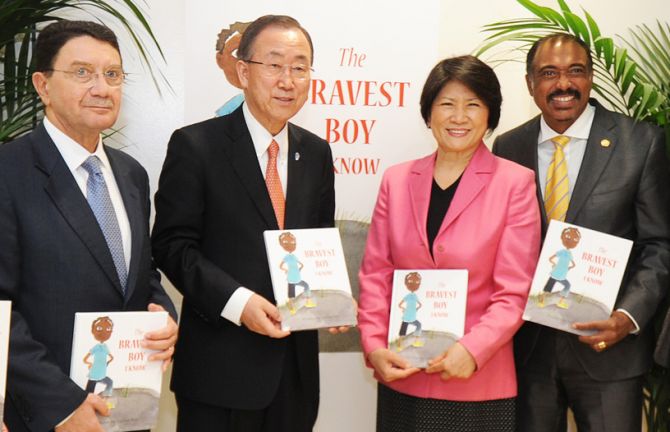

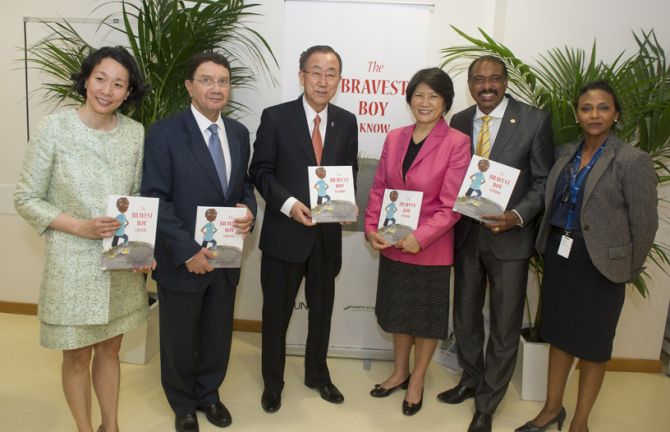
Press Release
UNAIDS and UNWTO ST-EP Foundation release a unique new book on HIV for children
08 May 2014 08 May 2014GENEVA/ROME, 8 May 2014—UNAIDS and the UN World Tourism Organization’s (UNWTO) Sustainable Tourism for Eliminating Poverty (ST-EP) Foundation have released a new book on HIV for children.
The book, The Bravest Boy I Know, is about two friends, Kendi and Kayla. Kendi is living with HIV. The story is set in Africa and beautifully illustrated by celebrated artist Sujean Rim. It is a heart-warming tale of how the two friends deal with HIV in a positive way. The book conveys the important message that by taking medicine children living with HIV can live active and healthy lives while also explaining that the medicines can make children feel unwell and tired.
The Bravest Boy I Know was officially launched in Rome by the United Nations Secretary-General Ban Ki-moon, Ambassador Dho Young-shim, Chairperson of the UNWTO ST-EP Foundation, Michel Sidibé, Executive Director of UNAIDS and Taleb D. Rifai, Secretary-General of UNWTO. It is dedicated to Mr Ban for his work in prioritizing education through the Global Education First Initiative which aims to put every child in school; improve the quality of learning; and foster global citizenship.
“Stigma and discrimination around HIV very often prevent children and families from accessing essential HIV prevention, testing, treatment and care services,” said Mr Ban. “These books, which will be delivered to schools across Africa through ST-EP’s Small Libraries project, will help everyone understand that young people can live normal and fulfilling lives with HIV."
Since November 2011, the ST-EP Foundation and UNAIDS have partnered to equip all UN MDGs Thank You Small Libraries with a UNAIDS corner so that all children can learn about HIV.
“As the UN MDGs Advocate for Education, I firmly believe in the power of education to accelerate the achievement of all UN MDGs by 2015, and particularly Goal 6—aimed at HIV,” said Ambassador Dho. “This meaningful collaboration with UNAIDS is creating synergies that will have a powerful impact on the education and the health of children.”
In 2012, some 3.3 million children under 15 years old were living with HIV and 650 000 were accessing antiretroviral treatment. Increasing access to simple and effective treatment for children is one of the major challenges in the AIDS response. In 2012, just 34% of children in need had access to the lifesaving treatment.
“As a father and a grandfather I know that reading to children can be the best way to help them understand complex issues,” said Mr Sidibé, Executive Director, UNAIDS. “We hope that this book will encourage acceptance and openness as well as spark action to address the specific needs of children living with HIV.”
The book is available in English and French with a Portuguese version to follow. It is being released together with a factsheet on children and HIV, a discussion guide for teachers and carers as well as a narrated video of the book.
To view the full package of materials online, please go to http://www.unaids.org/en/resources/campaigns/2014/20140508thebravestboyiknow/
UNAIDS
The Joint United Nations Programme on HIV/AIDS (UNAIDS) leads and inspires the world to achieve its shared vision of zero new HIV infections, zero discrimination and zero AIDS-related deaths. UNAIDS unites the efforts of 11 UN organizations—UNHCR, UNICEF, WFP, UNDP, UNFPA, UNODC, UN Women, ILO, UNESCO, WHO and the World Bank—and works closely with global and national partners to maximize results for the AIDS response. Learn more at unaids.org and connect with us on Facebook and Twitter.
UNWTO ST-EP Foundation
The UNWTO ST-EP Foundation is a cornerstone of the ST-EP (Sustainable Tourism for Eliminating Poverty) initiative of the World Tourism Organization (UNWTO) aimed to harness the power of tourism to generate new opportunities for development and empowerment in least developed and developing countries, and particularly in Sub-Saharan Africa. UNWTO ST-EP Foundation acts in cooperation with the Korean Ministry of Culture, Sports, and Tourism, GIZ, SNV, the Netherlands Development Organization, IUCN NL, and the Travel Foundation, etc.

Press Release
Global leaders commit to ending the AIDS epidemic in cities by 2030
20 July 2014 20 July 2014MELBOURNE, 20 July 2014—In a meeting initiated by UNAIDS and hosted by the city of Melbourne, Australia, global leaders agreed that cities and local leadership are the key to ending the AIDS epidemic by 2030. The inaugural Cities for Social Transformation meeting took place on the sidelines of the 20th International AIDS Conference. Mayors and representatives of 18 cities, governors, senior members of parliament, health ministers, a Head of State and senior health professionals attended the event.
The leaders committed to a rapid scale-up of prevention, treatment, care and support programmes, as well as addressing the needs of people at higher risk of HIV infection.
“It’s time to focus on local epidemics and city governments will be the driving force for change. They have the resources and the architecture to deliver essential social and health services,” said Michel Sidibé, Executive Director of UNAIDS. “They are the catalyst for forging new partnerships between communities, civil society and government. We will not end the AIDS epidemic without harnessing the power of cities.”
Ratu Epeli Nailatikau, the President of Fiji, Nafsiah Mboi, the Health Minister of Indonesia, Powes Parkop, the Governor of Papua New Guinea’s capital Port Moresby, Dhlomo Sibongiseni, the Health Minister of KwaZulu-Natal Province in South Africa, and Robert Doyle, Lord Mayor of Melbourne, shared their experiences.
"It’s an honour to be hosting this inaugural cities initiative mayors’ meeting. This is an important moment because I believe the world’s cities—our cities—have a pivotal role to play in leading the HIV response … and fulfilling the vision of an HIV-free generation,” said the Lord Mayor of Melbourne.
Current data show that 15 countries account for 75% of global HIV infections, with the majority found in urban centres. It is estimated that 220 cities globally account for over a third of HIV prevalence. In the Asia and the Pacific region, 30 cities account for over a million people living with HIV.
UNAIDS
The Joint United Nations Programme on HIV/AIDS (UNAIDS) leads and inspires the world to achieve its shared vision of zero new HIV infections, zero discrimination and zero AIDS-related deaths. UNAIDS unites the efforts of 11 UN organizations—UNHCR, UNICEF, WFP, UNDP, UNFPA, UNODC, UN Women, ILO, UNESCO, WHO and the World Bank—and works closely with global and national partners to maximize results for the AIDS response. Learn more at unaids.org and connect with us onFacebook and Twitter.
Contact
UNAIDSSaya Oka
tel. +41 79 540 83 07 or +61 4 7507 1409
okas@unaids.org
UNAIDS Bangkok
Artan Jama
tel. +66 94894 9235
jamaa@unaids.org
Photo galleries
Press centre
Download the printable version (PDF)

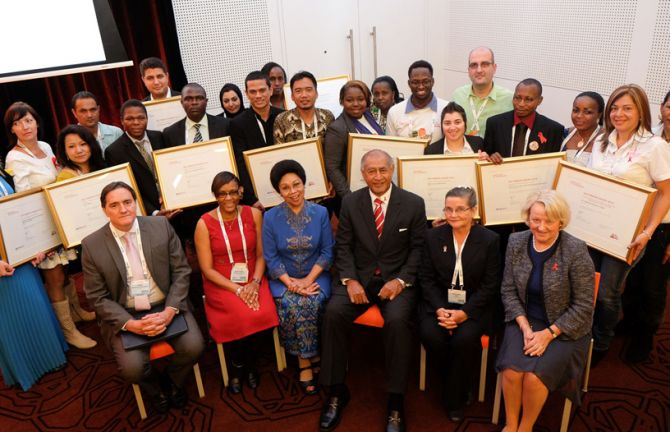
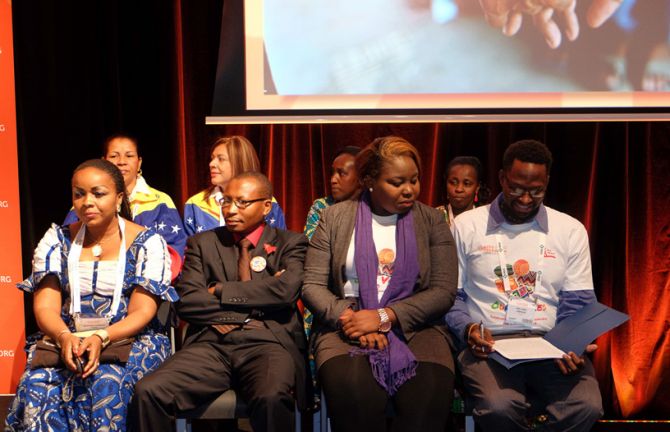
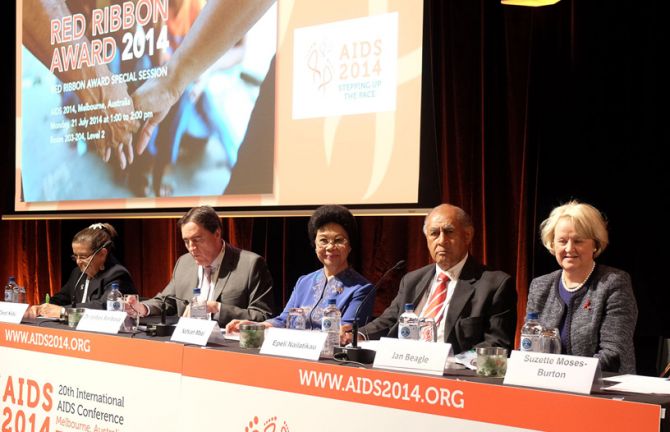
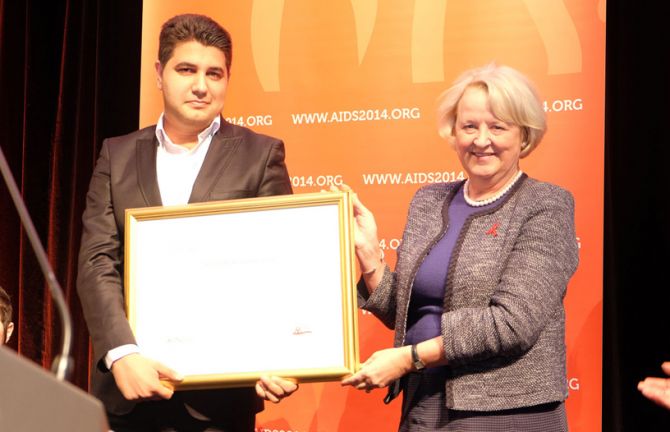
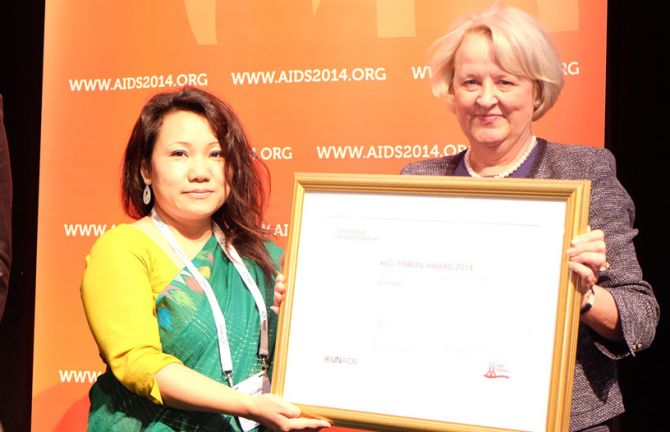
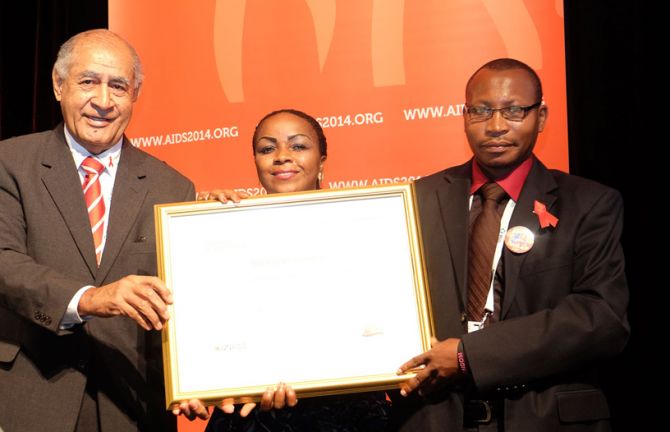
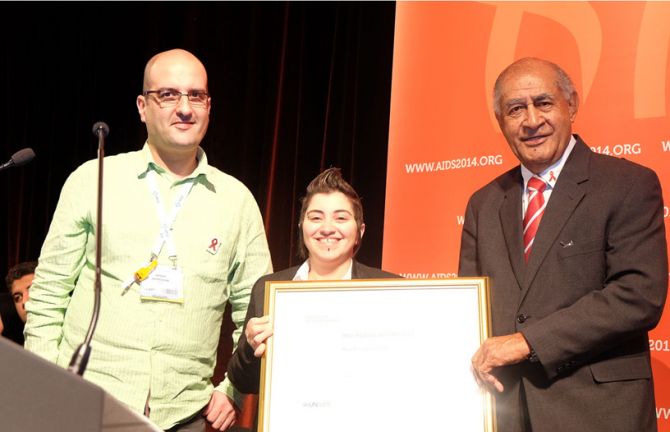
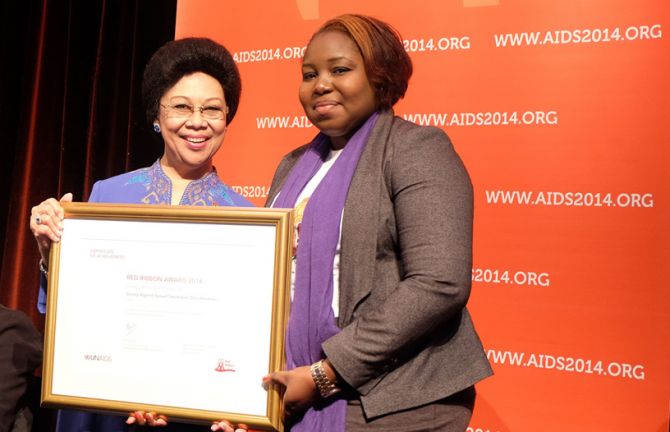
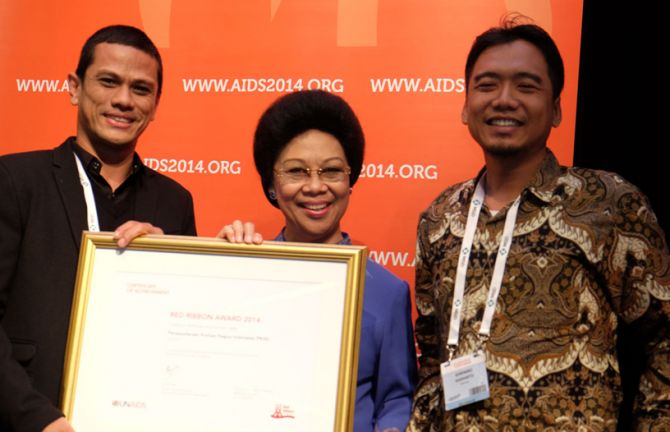
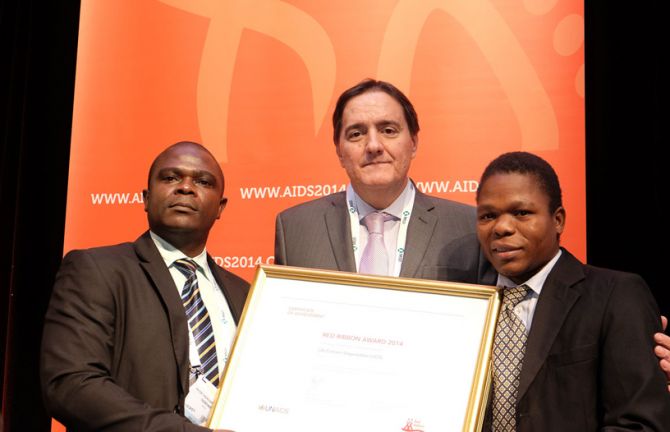
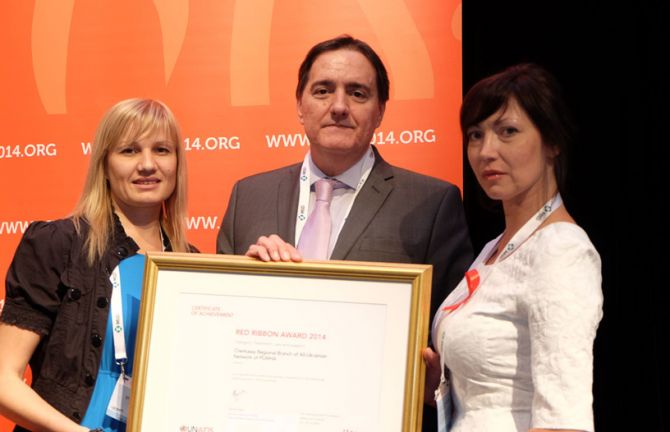
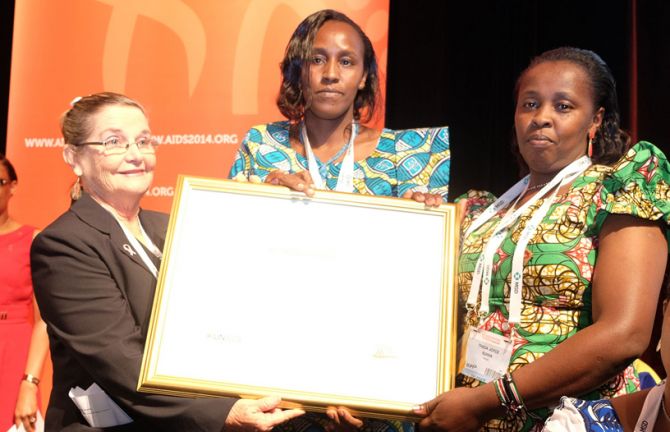

Press Release
Ten organizations receive Red Ribbon Award for outstanding community leadership on AIDS
21 July 2014 21 July 2014MELBOURNE, 21 July 2014—Ten exceptional community-based organizations have won the 2014 Red Ribbon Award for their inspiring work in reducing the impact of the AIDS epidemic. They were presented with the prestigious prize in a special session at the 20th International AIDS Conference (AIDS 2014) in Melbourne, Australia. The Red Ribbon Award is the world’s leading award for innovative and outstanding community work in the response to the AIDS epidemic.
Community-based organizations have shown the world how to mobilize for change in the AIDS response and the Red Ribbon Award recognizes their transformative achievements.
“In villages and townships across the globe, communities have taken matters into their own hands and come up with innovative solutions to what often appear as insurmountable problems in the AIDS response,” said UNAIDS Executive Director Michel Sidibé. “I congratulate the winners of the Red Ribbon Award 2014 for their courage, determination and dedication. Their leadership and cutting-edge thinking have brought us to where we are today.”
The 2014 winning organizations are from the Democratic Republic of the Congo, Guyana, Indonesia, Iran (Islamic Republic of), Kenya, Lebanon, Malawi, Nepal, Ukraine and Venezuela (Bolivarian Republic of). Almost 1000 nominations from more than 120 countries were received by the Red Ribbon Award secretariat, which is hosted by UNAIDS in partnership with other United Nations organizations, AIDS 2014, the Global Network of People Living with HIV, the International Community of Women Living with HIV/AIDS, the International Council of AIDS Service Organizations and Irish Aid. A global panel of civil society representatives selected the finalists from a shortlist determined by regional panels. Each of the winning organizations will receive a US$ 10 000 grant and have been invited to participate in AIDS 2014.
At the Red Ribbon Award special session, the winners were congratulated by Epeli Nailatikau, President of Fiji, Nafsiah Mboi, Minister of Health of Indonesia, Dr. Jarbas Barbosa, Vice Minister of Health of Brazil, Dame Carol Kidu, former Member of Parliament of Papua New Guinea and Jan Beagle, Deputy Executive Director, Management and Governance, UNAIDS.
President Nailatikau said, “This award honours the incredible innovation taking place at the grass roots. I am proud to give this award to organizations whose actions in the communities they serve truly make a huge difference to people affected by HIV.”
The Red Ribbon Award was first presented in 2006 and since then has been handed out every two years at the International AIDS Conference. This year there were five award categories. The 10 winners are listed below by category.
Category one: Prevention of sexual transmission
Action pour la Lutte contre l’Ignorance du SIDA (ALCIS) is a community-based organization founded in 1999 to prevent sexual transmission of HIV among young people and men who have sex with men in the context of sex work. It is the only organization in the Democratic Republic of the Congo to organize sex workers and men who have sex with men into solidarity committees that represent a collective and cooperative entity.
Marsa Sexual Health Centre provides marginalized sexually active young people, women, lesbian, gay, bisexual, transsexual, transgender and intersex people (LGBTI) and people living with HIV full access to sexual and reproductive health services.
Category two: Prevention among/by people who use drugs
Ehyaye Hayyate Sarmad is best known for its Red Ribbon Prison, which has provided treatment for drug users and organized workshops on sexual and reproductive health. Ehyaye Hayyate Sarmad is one of the first organizations in the Islamic Republic of Iran to work in the field of harm reduction and HIV in the prison system.
Dristi provides services and support to women who use drugs in Nepal. The organization is run by women who are former drug users and is dedicated to reducing the harmful impact of drug use through advocacy, treatment and support.
Category three: Treatment, care and support
Life Concern Organization (LICO) helps to improve the health and development of marginalized and vulnerable populations in Malawi. Since February 2009, LICO has worked to empower and lead an engaged community that can make informed decisions in the Rumphi district of northern Malawi.
Cherkassy Regional Branch of All-Ukrainian Network of PLWHA started as a self-help group to support the HIV-positive community. Over the past 12 years, the organization has worked to create systematic change at the regional level and to improve the quality of life through treatment, diagnosis and accompaniment for people living with HIV.
Category four: Advocacy and human rights
Society against Sexual Orientation Discrimination (SASOD) is dedicated to the eradication of homophobia in Guyana and throughout the Caribbean. SASOD has worked to repeal discriminatory Guyanese laws, change local attitudes about the LGBTI community and end discrimination in the government, workplace and community.
Perssaudaraan Korban Napza Indonesia (PKNI) is a leading national network representing the common priorities of 25 self-organized drug user groups across 19 provinces in Indonesia. PKNI was established in 2006 to address stigma, violence, discrimination and violations of human rights towards people who use drugs.
Category five: Stopping new HIV infections among children and keeping mothers alive, women’s health
Girl Child Counseling Women’s Group is a grass-roots women’s group that focuses on bringing together all community members to address the high rate of new HIV infections among women of childbearing age in Matunda, Kenya. The group vision is “A HIV free generation in the Matunda location.”
AC Mujeres Unidas por la Salud was created as a nongovernmental organization in the Bolivarian Republic of Venezuela in 2003 and is led by 35 women. Over the past years it has become an organization of reference at the national level for women living with HIV as a result of their efforts. It provides spaces where women can receive counselling, information and support.
For further information about this year’s winners and the Red Ribbon Award, please see the Red Ribbon Award website at www.redribbonaward.org.
The 2014 Red Ribbon Award on Social Media
Facebook: https://www.facebook.com/redribbon2014/timeline
Twitter: https://twitter.com/2014RedRibbon
About the Sponsors
UNAIDS
The Joint United Nations Programme on HIV/AIDS (UNAIDS) leads and inspires the world to achieve its shared vision of zero new HIV infections, zero discrimination and zero AIDS-related deaths. UNAIDS unites the efforts of 11 UN organizations—UNHCR, UNICEF, WFP, UNDP, UNFPA, UNODC, UN Women, ILO, UNESCO, WHO and the World Bank—and works closely with global and national partners to maximize results for the AIDS response. Learn more at unaids.org and connect with us onFacebook and Twitter.
UN partners
The UN partners involved in the Red Ribbon Award initiative bring together the efforts and resources of all UNAIDS Cosponsors and the UNAIDS Secretariat.
AIDS 2014
The XX International AIDS Conference (AIDS 2014) is the premier gathering for those working in the field of HIV, as well as policy makers, persons living with HIV and other individuals committed to ending the pandemic. It is a chance for stakeholders to take stock of where the epidemic is, evaluate recent scientific developments and lessons learnt, and collectively chart a course forward. AIDS 2014 will be held in Melbourne, Australia from 20 to 25 July 2014. (www.aids2014.org). The International AIDS Society is the convener and custodian of the conference.
Global Network of People Living with HIV
GNP+ is the global network for and by people living with HIV. GNP+ advocates to improve the quality of life of people living with HIV. Driven by the needs of people living with HIV worldwide, GNP+ supports people living with HIV through their organizations and networks. GNP+ works to ensure equitable access to health and social services, by focusing on social justice, rights and more meaningful involvement of people living with HIV in programme and policy development – the GIPA principle. (www.gnpplus.net)
International Community of Women Living with HIV/AIDS
ICW Global emerged to look for answers facing the desperate lack of support, information and services available for women living with HIV. The organization promotes the leadership and involvement of women living with HIV in spaces where policies and programmes are developed and implemented and where the decisions that affect the life of thousands of people who live with the virus are made. The vision is for a just world where women living with HIV are leaders in HIV programmes and policy and realize their universal rights. They dream of a world where women, young women, girls, adolescents living with HIV have full access to care and treatment and enjoy all of their rights: sexual, reproductive, legal, economic and health, regardless of culture, age, religion, sexuality, race or socio-economic status. (www.icwglobal.org)
International Council of AIDS Service Organizations
Founded in 1991, the International Council of AIDS Service Organizations’ (ICASO) mission is to mobilize and support diverse community organizations to build an effective global response to end AIDS. This is done within a vision of a world where people living with and affected by HIV can enjoy life free from stigma, discrimination, and persecution, and have access to prevention, treatment and care. The ICASO network operates globally, regionally and locally, and reaches over 100 countries internationally. (www.icaso.org)
Irish Aid
Irish Aid is the Government of Ireland's programme of assistance to developing countries. Its aid philosophy is rooted in Ireland's foreign policy, in particular its objectives of peace and justice. The international development policy "One World, One Future" reflects Ireland's longstanding commitment to human rights and fairness in international relations and is inseparable from Irish foreign policy as a whole. The Irish Aid programme has as its absolute priority the reduction of poverty, inequality and exclusion in developing countries, with a strong geographic focus on Sub-Saharan Africa. Improving access to quality essential social services such as health, education, services related to HIV and AIDS, and social protection is seen as key to the realisation of human rights, the reduction of poverty, hunger and inequality and the promotion of inclusive economic growth. (http://www.irishaid.gov.ie)
About the Red Ribbon Award
The red ribbon is a global symbol in the movement to address AIDS. The Red Ribbon Award, presented every two years at the International AIDS Conference, is designed to honor and celebrate community based organizations for their outstanding initiatives that show leadership in reducing the spread and impact of AIDS. The award is a joint effort of the UNAIDS family and as such, this year it will place particular emphasis on the organization's newly approved global priority areas of action.
The Red Ribbon Award was first given in 2006 and has recognized 85 organizations from over 50 different countries since then as leading community-based responses to AIDS. Such organizations lie at the heart of the response to the AIDS epidemic – displaying extraordinary courage, resilience and strength in addressing one of the greatest challenges of our time. Using creative and sustainable ways to promote prevention of sexual transmission, and prevention among people who use drugs, provide treatment, care, and support to people living with HIV and demonstrating innovation in the face of stigma and discrimination through advocacy and human rights, and stopping new HIV infections in children and keeping mothers alive, and taking care of women’s health, these examples of community leadership are showing us in practical terms how to reverse a global epidemic – one community at a time.
Right Hand side
Press centre
Download the printable version (PDF)
